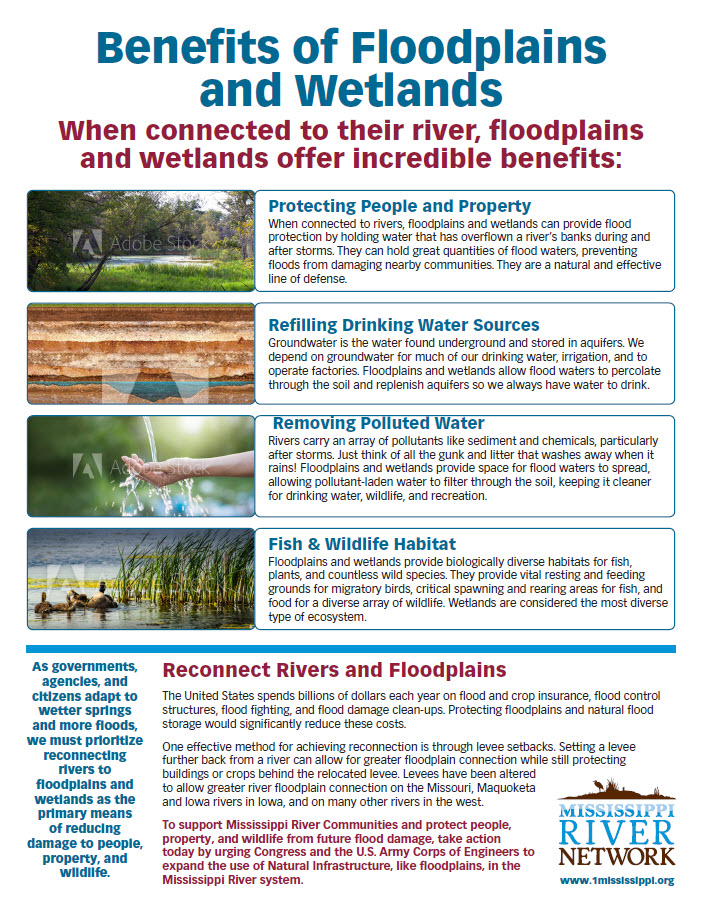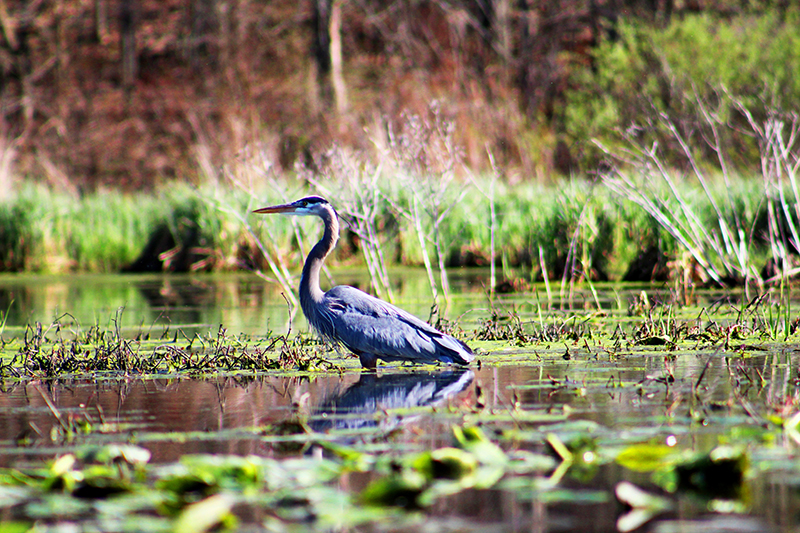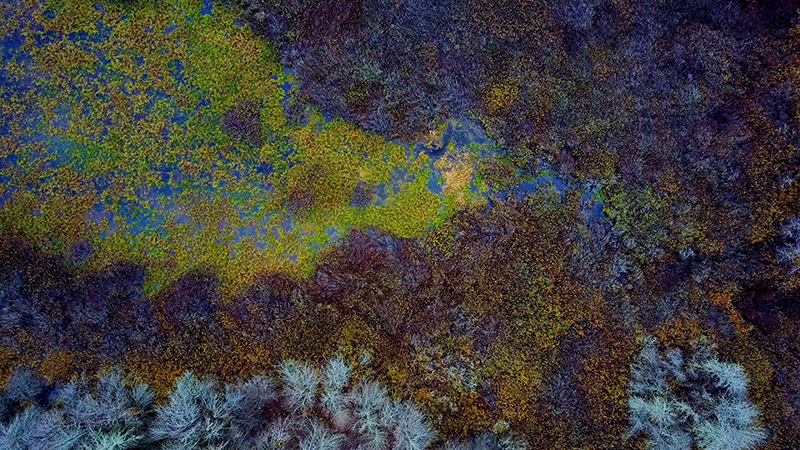Protecting Floodplains and Wetlands
How Floodplains and Wetlands Protect People, Property and Wildlife
Imagine a river. When asked, most people picture a rather narrow, somewhat meandering waterway with water that moves from one end to the other and onward, out of sight. In other words, people think of the channel of water that looks pretty much like a flowing road.
This isn’t wrong. And, the fact that the rivers of our imagination look a bit like roads is telling, but it isn’t the whole picture.
The whole picture of what a river is requires us to zoom out considerably. A river is so much more than the channel of water; it is also the land on both banks. This land is the floodplain and it is absolutely as much the river as the channel. When we disregard the floodplain and disconnect it from the channel, people and wildlife suffer the consequences.
Understanding Floodplains and Wetlands
Floodplains are the low-lying areas adjacent to rivers. Wetlands are land areas that are covered with water, either permanently or seasonally, and are frequently found on floodplains. When rivers overflow their channels, the water enters the floodplain. The natural rise and fall of river water into floodplains and wetlands gives extra water from snowy winters or wet springs somewhere to go. As flood waters enter the floodplain, they deposit nutrient-rich sediment, which is why they’ve been highly-prized as farm land for thousands of years.
A World Without Floodplains
Despite the many benefits of floodplains, rivers across the United States have been disconnected from their floodplains on a grand scale, largely through river channelization and levees. Sadly, this channelization and these levees have often been installed along with the false promise of permanent flood protection.
But, as river communities keep seeing, more and taller levees aren’t enough to hold back annual floods that seem to be getting worse.
A levee is typically an earthen wall built along a river channel to keep high flows within the channel and away from the land and structures behind the levee. The levee severs the connection between river and floodplain. Levees (and other engineered structures) can even make flooding worse by forcing flood waters into a narrower river channel, making the water flow higher, faster and with greater force, which can cause more powerful floods both up and downstream.
The Mississippi River alone has more than 2200 miles of identified levees, with many more that are unmapped and unidentified.
Stream channelization in smaller rivers also leads to river floodplain disconnection because water flows more quickly in channelized streams, leading to downward erosion and incision that leaves the stream bed so deep it can no longer overtop its banks and reach the floodplain area.
Once a river becomes disconnected from its floodplain, people no longer benefit from the floodplain. And, because levees can and often fail, people who were told their homes and business would be safe behind the walls suffer the serious consequences.
The Solution: Reconnect Rivers and Floodplains
The United States spends billions of dollars each year on flood and crop insurance, flood control structures, flood fighting, and flood damage clean-ups. Protecting floodplains and natural flood storage would significantly reduce these costs.
One effective method for achieving reconnection is through levee setbacks or removals. Setting a levee further back from a river can allow for greater floodplain connection while still protecting buildings or crops behind the relocated levee. In some situations, total removal of the levee may be warranted, or what’s known as notching or openings in the existing levee that allow floodwaters to reach the floodplain. Levees have been altered to allow greater river floodplain connection on the Missouri, Maquoketa and Iowa rivers in Iowa, and on many other rivers in the west.
As governments, agencies, and citizens adapt to wetter springs and more floods, we must prioritize reconnecting rivers to floodplains and wetlands as the primary means of reducing damage to people, property, and wildlife.
Floodplains and wetlands aren’t just an integral part of a river—they are essential for a healthy functioning river system and absolutely imperative to protect people, property, and wildlife from even more serious flooding. Floodplains and wetlands offer incredible benefits:
- Protecting People and Property– When connected to rivers, floodplains and wetlands can provide flood protection by holding water that has overflown a river’s banks during and after storms. They can hold great quantities of flood waters, preventing floods from damaging nearby communities. They are a natural and effective line of defense.
- Refilling Drinking Water Sources– Groundwater is the water found underground and stored in aquifers. We depend on groundwater for much of our drinking water, irrigation, and to operate factories. Floodplains and wetlands allow flood waters to percolate through the soil and replenish aquifers so we always have water to drink.
- Removing Polluted Water– Rivers carry an array of pollutants like sediment and chemicals, particularly after storms. Just think of all the gunk and litter that washes away when it rains! Floodplains and wetlands provide space for flood waters to spread, allowing pollutant-laden water to filter through the soil, keeping it cleaner for drinking water, wildlife, and recreation.
- Fish & Wildlife Habitat– Floodplains and wetlands provide biologically diverse habitats for fish, plants, and countless wild species. They provide vital resting and feeding grounds for migratory birds, critical spawning and rearing areas for fish, and food for a diverse array of wildlife. Wetlands are considered the most diverse type of ecosystem.

MORE RESOURCES
Step 1
Become a River Citizen
Yes! The River can count on me!
I am committed to protecting the Mississippi River. Please keep me informed about actions I can take to protect the Mississippi River as a River Citizen, and send me my free e-book!, Scenes From Our Mighty Mississippi!
Step 2
LEARN ABOUT THE RIVER
We protect what we know and love. As a River Citizen, you’ll receive our email newsletter and updates, which offer countless ways to engage with and learn more about the River. You can also follow us on Instagram, Facebook, X (Twitter) , and YouTube, where we share about urgent issues facing the River, such as nutrient pollution, the importance of floodplains and wetlands, and bedrock legislation such as Farm Bill Conservation Programs.
Step 3
Take Action
There are many ways you can jump in and take action for a healthy Mississippi River. Our 10 actions list includes simple steps you can take at any time and wherever you are. Check out our action center for current action alerts, bigger projects we are working on, and ways to get involved.


